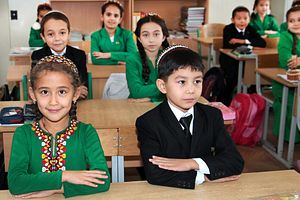For much of the former Soviet space, any demographic analysis focuses on the remarkable projected decline in the region’s population. Highlighting Russia’s impending fall-off is often the most popular regional theme, so much so that this reality has even engendered (misguided) pushback.
A new round of projections from the United Nations enforces this reality – but illustrates how Central Asia bucks this regional trend. For while Russia, the Caucasus, and the Baltics will likely hemorrhage denizens over the coming decades, every Central Asian state will almost certainly see increasing numbers through the year 2100.
Before diving into the Central Asian numbers, it’s worthwhile to examine just how steep the UN projects the dives elsewhere to be. Russia, per the UN, will see an 18 percent decline through 2100, plummeting from 143,457,000 current citizens to 117,445,000 in 85 years. Belarus and Armenia, Kazakhstan’s Eurasian Union partners, will see drop-offs of 27 percent and 41 percent, respectively. Even Azerbaijan, despite similar ethno-cultural makeups to its neighbors across the Caspian, will see its population drop slightly through 2100.
Central Asia, however, bucks this trend in the former Soviet space. Tajikistan leads the pack, with the UN predicting a growth of a staggering 119 percent between 2015 and 2100, swelling the population from 8,482,000 to 18,559,000. While not nearly at the same rate, Kyrgyzstan still boasts impressive 52 percent projected growth. And Kazakhstan, despite an aging Slavic population, has a surprising 40 percent growth forecast – almost entirely through its Turkic population(s), presumably. Uzbekistan and Turkmenistan, meanwhile, will see growth in the single digits – tepid, but growth nonetheless. In terms of sheer numbers, the region’s ordering will presumably remain identical to its current set-up: Uzbekistan will retain the region’s largest population, followed by Kazakhstan, Tajikistan, Kyrgyzstan, and Turkmenistan.
However, while these states will presumably manage to avoid the looming issues facing those with diminishing populations, Central Asia’s projected growth – especially in Kyrgyzstan and Tajikistan – will only exacerbate current structural weaknesses. Limited employment opportunities, climate change realities, disputes over water usage, and border delimits – all will only increase in importance as the populations swell. External migration, while stunted for the time being, will likely ease the forthcoming pressures. And not only in Russia: China, for instance, is projected to see a 27 percent decline through 2100. (India, on the other hand, has the UN projecting a 27 percent increase in population.)
But these shifts remains years out. For the time being, the UN can help paint a more accurate picture of Central Asia’s future, decades out – but it’s the local governments that will need to provide the wherewithal to prepare for the issues that loom in the future.

































